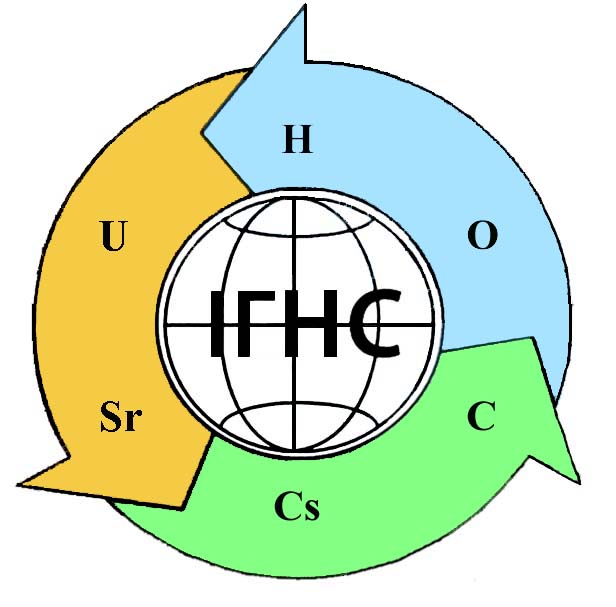GEOCHEMICAL MARKERS OF ECOSYSTEM DEGRADATION DUE TO MILITARY AGGRESSION
DOI:
https://doi.org/10.32782/geotech2024.38.08Keywords:
environment, pollution, russian aggression, explosives, evidence base, cause and effect relationship.Abstract
The urgent need to form an applied field – forensic geochemistry – due to the development of technogenesis is especially relevant to the destruction of ecological functions of the environmental systems as a result of russian aggression. The main task of this field is to create an evidence base for the cause-and-effect relationship between the activities of man-made facilities as well as military operations and environmental pollution. Its methodology is based on the definition of geochemistry as the science of the history of chemical elements of the earth’s crust (according to Vernadsky) and declares the priority of the Laws of Nature over the Laws of Society in the spatial and temporal aspect. The roadmap of research on isotopic and geochemical identification of changes in productivity, species and chemical composition of biomass of ecosystems affected by military aggression is discussed. At the same time, the key element in identifying disturbances (degradation) of biogeocenosis is the soil, which is located at the intersection of all pathways of substance migration. The chemical composition of explosives was analyzed, specific markers and promising ways of their migration and accumulation in environmentally important components of the landscape (soil, plants, pore solutions, etc.) were identified. Some biogeochemical markers are proposed, the change (degradation) of which clearly indicates a causal relationship with military actions, as well as isotopic and geochemical markers, which allow to identify the time period of these changes. Species that are common in all natural zones of Ukraine – southern reed, willow, poplar, spruce, pine are accumulate explosive residues and products of their incomplete decomposition and can serve as biological indicators of environmental pollution as a result of military actions. At the same time, some of these species can be used for phytoremediation, for example, southern reed may use for phytoextraction of trinitrotoluene from water bodies in the combat zone. The research was supported by the Alexander von Humboldt Foundation (Grant 1232235 MSCA4Ukraine).
References
UKRAINE Third Rapid Damage and Needs Assessment (RDNA3) February 2022 – December 2023: Editor: Anne Himmelfarb: the World Bank, the Government of Ukraine, the European Union, the United Nations. https://ukraine.un.org/sites/default/files/2024-02/UA%20RDNA3%20report%20EN.pdf.
Методика оцінки збитків від наслідків надзвичайних ситуацій техногенного і природного характеру : затверджено постановою Кабінету Міністрів України від 15.02.2002 № 175. https://zakon.rada.gov.ua/laws/show/175-2002-%D0%BF#Text.
Методика розрахунку екологічних збитків природних екосистем та їхніх компонентів : посібник / Я. П. Дідух, У. М. Соколенко, В. В. Расевич, С. О. Гаврилов [за заг. ред. та упор. О. В. Кравченко]. Львів – Київ : Видавництво «Компанія “Манускрипт”», 2024. 68 с. ISBN 978-617-8364-10-6.
Економічна оцінка збитків від забруднення довкілля : методичні вказівки до виконання самостійної роботи студентів із кредитного модуля «Еколого-економічна оптимізація виробництва» для студентів напряму підготовки 6.050101 «Комп’ютерні науки», програм професійного спрямування «Комп’ютерний еколого-економічний моніторинг» / Уклад. Н. В. Караєва. Київ : НТУУ «КПІ», 2015. 51 с.
Методика визначення розмірів шкоди, зумовленої забрудненням і засміченням земельних ресурсів через порушення природоохоронного законодавства (редакція від 12.01.2021) : затверджено наказом Міністерства охорони навколишнього природного середовища від 27.10.1997 № 171, наказом Мінприроди від 04.04.2007 № 149; зареєстровано в Міністерстві юстиції України 05.05.1998 за № 285/2725. https://zakon.rada.gov.ua/laws/show/z0285-98#Text.
Методика розрахунку розмірів відшкодування збитків, які заподіяні державі в результаті наднормативних викидів забруднюючих речовин в атмосферне повітря: затверджено наказом Міністерства енергетики та захисту довкілля України від 28.04.2020 № 277 : зареєстровано в Міністерстві юстиції України 07.05.2020 за № 414/34697. https://zakononline.com.ua/documents/show/485325___652648.
Методика розрахунку розмірів відшкодування збитків, заподіяних державі внаслідок порушення законодавства про охорону та раціональне використання водних ресурсів (редакція від 05.03.2024) : затверджено наказом Міністерства охорони навколишнього природного середовища України від 20.07.2009 № 389, зареєстровано в Міністерстві юстиції України 14.08.2009 за № 767/16783. https://zakon.rada.gov.ua/laws/show/z0767-09#Text.
Методики визначення розміру шкоди, заподіяної внаслідок самовільного зайняття земельних ділянок, використання земельних ділянок не за цільовим призначенням, псування земель, порушення режиму, нормативів і правил їх використання (редакція від 28.12.2022) : затверджено постановою КМУ № 963 від 25.07.2007. https://zakon.rada.gov.ua/laws/show/963-2007-%D0%BF#Text.
Методика визначення розмірів відшкодування збитків, заподіяних державі внаслідок самовільного користування надрами (редакція від 18.11.2022) : затверджено наказом Міністерства екології та природних ресурсів України від 29.08.2011 № 303; зареєстровано в Міністерстві юстиції України 28.10.2022 за № 1337/38673. https://zakon.rada.gov.ua/laws/show/z1337-22#Text.
Про затвердження такс для обчислення розміру шкоди, заподіяної лісу : постанова Кабінету Міністрів України від 23.07.2008 № 665 (редакція від 17.09.2020). https://zakon.rada.gov.ua/laws/show/665-2008-%D0%BF#Text.
Про затвердження спеціальних такс для обчислення розміру шкоди, заподіяної порушенням законодавства про природно-заповідний фонд : постанова Кабінету Міністрів України від 10 травня 2022 р. № 575. https://zakon.rada.gov.ua/laws/show/575-2022-%D0%BF#n20.
Про затвердження такс для обчислення розміру шкоди, завданої порушенням законодавства про рибне господарство внаслідок незаконного добування (вилову), знищення або пошкодження водних біоресурсів, а також незаконного знищення чи погіршення середовища існування водних біоресурсів : постанова КМУ від 29 вересня 2023 р. № 1042. https://zakon.rada.gov.ua/laws/show/1042-2023-%D0%BF#n27.
Положення про порядок обчислення розміру відшкодування та сплати збитків, заподіяних внаслідок забруднення із суден, кораблів та інших плавучих засобів територіальних і внутрішніх морських вод України : затверджено наказом Міндовкілля 16.01.2021 № 16; зареєстровано в Міністерстві юстиції України 26 березня 2021 р. за № 406/36028. https://zakon.rada.gov.ua/laws/show/z0406-21#Text.
Методика обчислення розміру збитків від забруднення нафтою : затверджено постановою КМУ від 26 квітня 2003 р. № 631 (редакція від 17.09.2020). https://zakon.rada.gov.ua/laws/show/631-2003-%D0%BF#Text.
Такси для обчислення розміру відшкодування збитків, заподіяних підприємствами, установами, організаціями і громадянами України, іноземними юридичними особами та громадянами внаслідок забруднення із суден, кораблів та інших плавучих засобів територіальних і внутрішніх морських вод України : затверджено постановою КМУ від 3 липня 1995 р. № 484 (редакція від 09.01.2013). https://zakon.rada.gov.ua/laws/show/484-95-%D0%BF#Text.
Методика розрахунку неорганізованих викидів забруднюючих речовин або суміші таких речовин в атмосферне повітря внаслідок виникнення надзвичайних ситуацій та/або під час дії воєнного стану та визначення розмірів завданої шкоди : наказ Міндовкілля № 175 від 13.04.2022; зареєстровано в Міністерстві юстиції України 16 квітня 2022 р. за № 433/37769. https://zakon.rada.gov.ua/laws/show/z0433-22#Text.
Dolin V.V., Smirnov V.N., Smirnova S.M. Methodical approaches to the assessment of the degree of anthropogenic load on bottom sediments (by the example of the South Bug estuary). Пошукова та екологічна геохімія. 2007. № 1 (6). С. 36–42.
Smirnovа S.M., Dolin V.V. Heavy metal content in soils within Mykolayiv city agglomeration. Зб. наук. праць Ін-ту геохімії навколишнього середовища НАН та МНС України. Київ, 2009. Вип. 17. С. 36–44.
Smirnovа S.M., Dolin V.V. Heavy metal content in Snow cover of Mykolaiv city. Зб. наук. праць Ін-ту геохімії навколишнього середовища НАН та МНС України. Київ, 2011. Вип. 19. С. 115–124.
Dolin V., Smyrnov V., Ischuk O., Orlov O. Technogenic & Environmental Safety of Bug Estuary Biogeosystem Affected with Heavy Metal Contamination / Sobotovich E. (Ed.): Kyiv – Mykolayiv: RAL-polygraph, 2011. 200 p. DOI: 10.13140/2.1.2179.3609.
Dolin V.V., Smirnova S.M. Geoecological approaches to the study of heavy metals in Mykolayiv urban agglomeration. Український журнал Економіст. 2012. № 6 (308). С. 46–49.
Про затвердження нормативів гранично допустимих концентрацій небезпечних речовин у ґрунтах, а також переліку таких речовин : постанова Кабінету Міністрів України від 15.12.2021 № 1325. https://zakon.rada.gov.ua/laws/show/1325-2021-%D0%BF#Text.
Фоновий вміст мікроелементів у ґрунтах України / за ред. А. І. Фатєєва, Я. В. Пащенка. Харків, 2003. 72 с.
Dolin, V. (2009), Evaluation of Sustainability of the Carbon and Silicon Ecosystem: From Nanoparticles to Macroworld. In: Magarshak, Y., Kozyrev, S., Vaseashta, A.K. (eds) Silicon Versus Carbon. NATO Science for Peace and Security Series B: Physics and Biophysics. Springer, Dordrecht. https://doi.org/10.1007/978-90-481-2523-4_19.
Organic Chemistry of Explosives J.P. Agrawal and R.D. Hodgson (2007). John Wiley & Sons, Ltd. ISBN: 0-470-02967-6.
Cooper, Paul W. Explosives engineering. VCH, New York, N.Y., 1996. 460 р. ISBN: 9781560819271, 9780471186366, 1560819278, 0471186368; OCLC Number / Unique Identifier: 34409473.
Посібник для України «Вибухові боєприпаси», GICHD, 2022. https://www.gichd.org/fileadmin/uploads/gichd/Publications/GICHD_Ukraine_Guide_in_Ukrainian__2022.pdf.
Забруднення земель внаслідок агресії Росії проти України / А. Сплодитель, О. Голубцов, С. Чумаченко, Л. Сорокіна. 154 с. https://ecoaction.org.ua/wp-content/uploads/2023/03/zabrudnennia-zemel-vid-rosii.pdf.
Важкі метали у компонентах навколишнього середовища м. Маріуполь (еколого-геохімічні аспекти) / С. П. Кармазиненко, І. В. Кураєва, А. І. Самчук, Ю. Ю. Войтюк, В. Й. Манічев. Київ : Інтерсервіс, 2014. 168 с. [32] с. кол. іл.: іл.
Pennington, J.C., Brannon, J.M. (2002), Environmental fate of explosives. Thermochim. Acta 384, 163–172.
Taylor, S., Bigl, S., Packer, B. (2015), Condition of in situ unexploded ordnance. Sci. Total. Environ 505, 762–769.
Kiiskila, J.D., Das, P., Sarkar, D., Datta, R. (2015), Phytoremediation of explosive-contaminated soils. Curr. Pollut. Rep. 1, 23–34.
Pichtel, J. (2012), Distribution and fate of military explosives and propellants in soil: a review. Appl. Environ. Soil. Sci.Article ID 617236. https://doi.org/10.1155/2012/617236.
Непомітні наслідки війни. https://drukarnia.com.ua/articles/nepomicheni-naslidki-viini-ojwLe#heading-2-3149 (assessed 19.07.2024).
Kaplan D.L. and Kaplan A.M. Thermophilic biotransformations of 2,4,6-trinitrotoluene under simulated comporting conditions. Applied Environmental Microbiology. 1982. 44 (3). P. 757–760.
DuBois, F.W. and Baytos, J.F (1972), Effect of Soil and Weather on the Decomposition of Explosives. Los Alamos Scientific Laboratory Report LA-4943.
DuBois, F.W. and Baytos, J.F. (1991), Weathering of Explosives for Twenty Years. Los Alamos National Laboratory Report LA-11931.
Becker, N.M. (1995), Fate of selected high explosives in the environment: literature review. Los Alamos National Laboratory Report LA-UR-95-1018.
Spanggord R.J., Mabey W.R., Chou T.W. et al. Environmental fate of selected nitroaromatic compounds in the aquatic environment. In: Rickert DE, ed. Chemical industry institute of toxicology series: Toxicity of nitroaromatic compounds. Washington, DC: Hemisphere Рublishing Сorporation, 1985. Р. 15–34.
Pennington J.C. Soil sorption and plant uptake of 2,4,6-trinitrotoluene. Technical Report EL-88-12. Environmental Laboratory of Waterways Experimental Station. Vicksburg, 1988. 173 p.
Liu, D.H.W., Spanggord, R.J., Bailey, H.C. et al. (1983), Toxicity of TNT wastewaters to aquatic organisms. Volume I: Acute toxicity of LAP wastewaters to 2,4,6-trinitrotoluene. Final report. Contract № DAMD17-75-C-5056. Menlo Park, CA: Stanford Research Institute. Document № ADA142-144.
Palazzo, A.J., Leggett, D.C. (1986), Effect and disposition of TNT in a terrestrial plant. J. Environmental Quality. 15 (1). P. 49–52.
Nepovim A., Hebner A., Soudek P., Gerth A., Thomas H., Smrcek S., Vanek T. Degradation of 2,4,6-trinitrotoluene by selected helophytes. Chemosphere. 2005. 60. P. 1454–1461. DOI: 10.1016/j.chemosphere.2005.01.073.
Simini M., Checkai R.T., Kuperman R.G., Phillips C.T., Kolakowski J.E., Kurnas C.W. Toxicities of TNT and RDX to terrestrial plants in five soils with contrasting characteristics. Project ECBC-TR-1091. Edgewood Chemical Biological Center. Aberdeen Proving Ground, MD, 2013. 54 p.
Best E.P.H., Tatem H.E., Geter K.N., Wells M.L., Lane B.K. Effects, uptake, and fate of 2,4,6‐trinitrotoluene aged in soil in plants and worms. Environmental Toxicology and Chemistry. 2008. 27 (12), 2539. 10.1897/08-017.1.
Scheidemann P., Klunk A., Sens C., Werner D. Species dependent uptake and tolerance of nitroaromatic compounds by higher plants. Journal of Plant Physiology. 1998. 152 (2–3). P. 242–247. 10.1016/S0176-1617(98)80139-9.
Zhang B., Kendall R.J., Anderson T.A. Toxicity of the explosive metabolites hexahydro-1,3,5-trinitroso-1,3,5-triazine (TNX) and hexahydro-1-nitroso-3,5-dinitro-1,3,5-triazine (MNX) to the earthworm Eisenia fetida. Chemosphere. 2006. 64 (1). P. 86–95. 10.1016/j.chemosphere.2005.11.037.
Schoenmuth B.W., Pestemer W. Dendroremediation of trinitrotoluene (TNT). Part 1: Literature overview and research concept. Environmental Science and Pollution Research. 2004. 11 (4). P. 27–278. 10.1007/BF02979637.
Meyers S.K., Deng S., Basta N.T., Clarkson W.W., Wilber G.G. Long-term explosive contamination in soil: effects on soil microbial community and bioremediation. Soil and Sediment Contamination: An International Journal. 2007. 16 (1). P. 61–77. 10.1080/15320380601077859.
Johnson M.S., Vodela J.K., Reddy G., Holladay S.D. Fate and the biochemical effects of 2,4,6-trinitrotoluene exposure to tiger salamanders (Ambystoma tigrinum). Ecotoxicology and Environmental Safety. 2000. 46 (2). P. 186–191. doi.org/10.1006/eesa.1999.1893.
Alothman Z.A., Bahkali A.H., Elgorban A.M., Al-Otaibi M.S., Ghfar A.A., Gabr S.A., Wabaidur S.M., Habila M.A., Hadj Ahmed A.Y.B. Bioremediation of Explosive TNT by Trichoderma viride. Molecules. 2020. 25. 1393. DOI: 10.3390/molecules25061393.
Hathaway J.A. Subclinical eff ects of trinitrotoluene: A review of epidemiology studies. In: D.E. Rickett, ed. Toxicity of nitroaromatic compounds. New York: Hemisphere Publishing Corporation, 1985. P. 255–274.
Li Y., Jiang Q, Yao S. et al. Effects of exposure to trinitrotoluene on male reproduction. Biomedical and Environmental Sciences. 1993. 6. P. 154–l60.
Savolainen H., Tenhunen R., Harkonen H. Reticulocyte haem synthesis in occupational exposure to trinitrotoluene. British J. Ind. Med. 1985. 42 (5). P. 354–355.
Sawsan S.S., El-Ghazali M.M., El-Batanouni M.M. et al. Chromosomal aberrations among workers engaged in the explosives industry. In: Foa V, Emmett EA, Maroni M, et al., eds. Occupational and environmental chemical hazards: Cellular and biochemical indices for monitoring toxicity. New York: Halsted Press, 1987. P. 466–472.
Bolt H.M., Degen G.H., Dorn, S.B., Plöttner S., Harth V. Genotoxicity and potential carcinogenicity of 2,4,6-trinitrotoluene: Structural and toxicological considerations. Rev. Environ. Health. 2006. 21. P. 217–228.
Koske D., Goldenstein N.I., Kammann U. Nitroaromatic compounds damage the DNA of zebrafish embryos (Danio rerio). Aquat. Toxicol. 2019. 217. 105345.
Lee C.C., Dilley J.V., Hodgson J.R., Hatton D.O., Wiegard W.J., Roberts U., Halfpap L.H., Kurtz L.D, West N. Mammalian toxicity of munitions compounds; Phase I – Acute oral toxicity, primary skin and eye irritation, disposition and metabolism. Midwest Research Institute, Kansas City, Mo, 1975. 256 p.
Davydchuk V.S., Zarudnaya R.F., Mikheli S.V., Petrov M.F., Sorokina L.Y., Tkachenko A.N. Landscapes of the Chornobyl Zone and their assessment of radionuclide migration conditions. Edited by A.M. Marinich. Кyiv: Naukova dumka, 1994. 112 p.
Richter-Torres P., Dorsey A., Hodes C.S. Toxicological profile for 2,4,6-Trinitrotoluene. U.S. Department of Health and Human Services. Atlanta, Georgia, 1995. 208 p.









